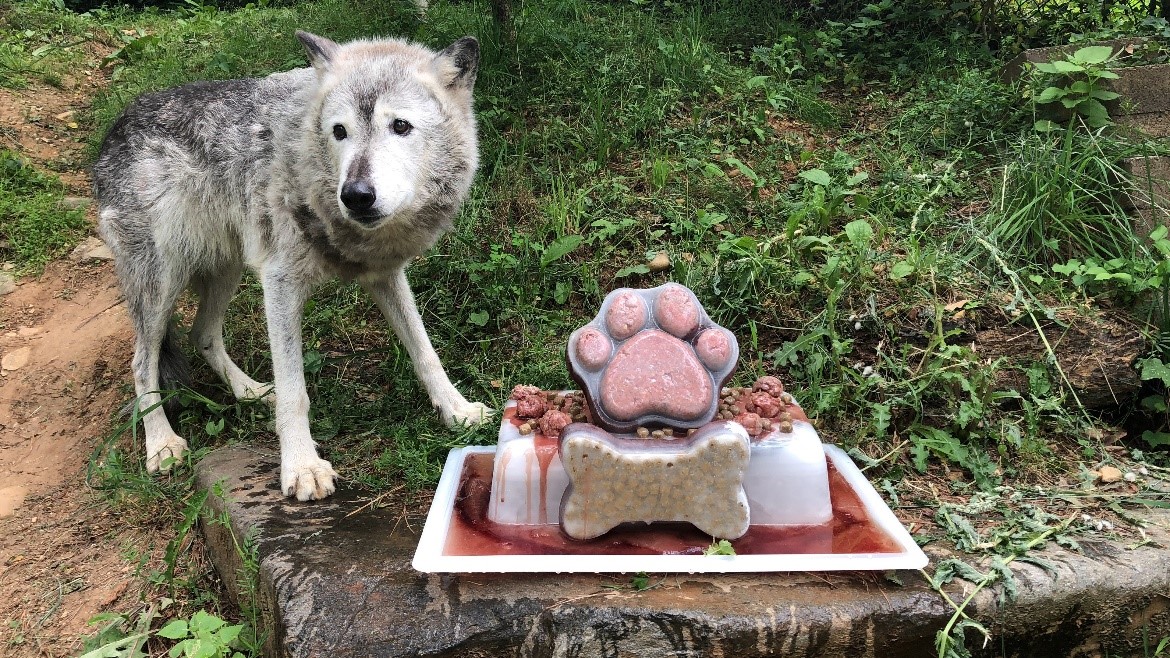Elderly Gray Wolf Dies at Smithsonian’s National Zoo
American Trail keepers at the Smithsonian’s National Zoo are mourning the loss of Coby, a female gray wolf who was humanely euthanized Sept. 30. At 16 years old, Coby was considered geriatric for her species. The median life expectancy for a gray wolf is about eight years in the wild; in human care, the typical life span is 10 to 15 years.
In early August, American Trail keepers noticed Coby limping in her habitat and favoring, or not placing weight on, her left-rear leg. Zoo veterinarians examined her and took radiographs, which revealed a fracture in her femur. Because the break was clean and Coby was in good health despite her advanced age, animal care staff elected to repair the break. An outside veterinary surgeon placed a plate along the femur to stabilize the bone. While Coby recovered at the Zoo’s veterinary hospital, veterinarians administered laser therapy treatment to aid healing. Six weeks following her initial surgery, an exam revealed the plate had broken, the femur had fractured again and there was evidence of additional fractures in the bone. Staff did not observe any behavior that would explain how or why the plate broke. Because of her advanced age and the risk that a second surgical procedure could predispose her to other medical issues, staff determined it would diminish her quality of life and elected to humanely euthanize Coby based on her poor long-term prognosis.
Coby arrived at the Smithsonian’s National Zoo in 2012 from the Calgary Zoo in Canada along with another female gray wolf, Crystal. Although Coby and Crystal were not related, they were hand-raised together as pups and served as companions to one another when they were younger. Most Zoo animals participate in the Association of Zoos and Aquariums’ Species Survival Plan (SSP). The SSP scientists choose which animals to breed by considering their genetic compatibility, personality, health and temperament, among other factors. Rather than breed, Coby served as an ambassador for her species, teaching Zoo staff and visitors about gray wolf biology, behavior, socialization and the important role they play as top predators in the ecosystem.
American Trail keepers fondly remember Coby as the “treasure” of American Trail. Because she was hand-raised as a pup, Coby was comfortable around and bonded to her keepers. She would often follow them as they walked past her habitat and greeted them in the mornings. As a younger wolf, she was quite reserved and would often let her exhibit mate, Crystal, investigate new people and situations first. The pair would often howl in unison whenever they heard sirens. As Coby aged, keepers say she became a much more relaxed and accepting wolf.
Native to the northern United States and Canada, gray wolves are classified as least concern by the International Union for Conservation of Nature. Gray wolves once had one of the largest natural ranges of any terrestrial mammal in the Northern Hemisphere. Human expansion into the Western United States placed wolves and humans in conflict. Hunting and poisoning devastated wolf populations, and they nearly went extinct. The Endangered Species Act of 1973 helped reestablish wolf populations by providing legal protection from the unregulated killing of gray wolves by humans. Today, the gray wolf population has stabilized due to a combination of factors, including legal protections, human migration to more urban areas and land-use changes. The reintroduction of the gray wolf to areas of North America is an incredible conservation success story and has transformed and restored environments that were on the brink of collapse.
# # #
SI-307-2020
Jen Zoon
301-908-3102

